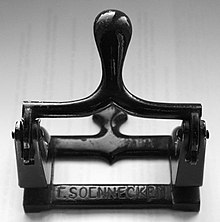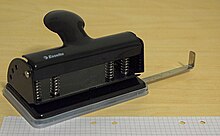Perforator
A hole punch (or perforator ) is a tool in the office to punch holes in the edge of sheets of paper at a defined distance . Purpose of the holes is the filing of the paper in a file folder , loose-leaf binders or scheduler .
The hole punch is a punching tool . Paper drills are used for punching thick stacks of paper .
history

The Sauerland Friedrich Soennecken invented in Bonn the first mechanical and portable hole punch for paper. On November 14th, 1886 the Imperial Patent Office granted him the patent DRP 40065 for a paper hole punch for folders, letter folders and the like. like. The first separate Handperforator ( "Phoenix") was 1901 by the Stuttgart company Leitz sold, the previously named after her Leitz files had invented its original form but also came Soennecken from the house. From 1904 Leitz sold the document punch for authorities , in 1925 this paper punch was provided with a center mark.
Technical
To center the holes, the paper is either placed on an adjustable rail or a center marking (line, sharp points on the hole punch) is used. By folding it halfway on the side to be punched and then placing the center mark on the crease, you center the sheet so that you can now punch it.
The distance between the holes is determined by the perforator. For A4 and A5 paper formats , for example, it is eight cm (center hole to center hole measured), the center is 148.5 mm and 105 mm respectively. The holes themselves are about 6 mm in diameter. The distance from the edge of the sheet to the center of the hole is between 11 and 13 mm according to ISO.
For sheets of paper in A4 format, there are punches with two or four holes (3 × 80 mm), and for A5 pages as well (the four-hole version has a spacing of 45-65-45 mm). There are also other punches for special purposes, e.g. six holes for the DIN A5 format, which are arranged in two groups of three (→ Filofax scheduler).
The steel pins that punch the holes in the paper are called punch pipes .
To punch a stack of 85 sheets (85 g / m²) of paper with a 2-hole punch, the punching pipes must be pressed through the paper with 765 daN . Occurring frictional forces are taken into account. The perforators are designed so that a pressure force of the operator of a maximum of 45 daN is sufficient to be able to comfortably punch the specified maximum number of sheets. Sharp (i.e. newly produced) steel perforated pipes may well require less force. In addition, the operating force required depends on the shape of the punch head.
There are various hole punch models for home use, the office and particularly flat and space-saving designs for on the go. Many small and medium-sized punches have an approximately rectangular recess in the lever plate, which serves as a bottle opener , like the one in the picture “Using a paper punch”.
In the Baden judiciary, a special Baden hole punch is used, with which files can be punched on the upper left-hand side (cf. Baden files ).
Executions
International standards and hole systems
ISO 838
The most widely used standard for hole size and spacing is described in the international standard ISO 838. The holes have a diameter of 6 ± 0.5 mm. The hole centers are 80 ± 0.5 mm apart and have a distance of 12 ± 1 mm to the edge of the paper. The center of the hole is in the center of the paper edge.
The perforation according to ISO 838 is suitable for all paper formats with a height of at least 100 mm, i.e. ISO A7 and larger. The width of the edge of the hole is intended to be 20 to 25 mm.
"888", 4-hole extension from ISO 838
There is an extension of the ISO-838 punching that uses four holes. The middle two are placed in accordance with ISO 838, two more holes are placed at a distance of 80 mm above and below, so that all holes are 80 mm apart. Therefore, this hole is often referred to as the 888. However, it is not officially standardized.
This extension is sometimes used in ring binders to give the leaves a better hold. Sheets perforated according to this extension also fit in ISO-838 folders. Some ISO-838 perforators have a guide rail with "888" marking or "3 × 8" marking and can therefore also be used for this perforation. First the bottom two holes are punched, then the top two holes on the turned paper.
This perforation is suitable for all paper formats with a height of at least 260 mm, i.e. ISO A4 and larger. The above procedure is not possible for ring binders in A5 format with 4-hole punching, as the hole spacing here is 45-65-45 mm. In order to still use a normal punch with a stop rail, the 3 × 8 or 888 marking can only be used for the outer holes (as with A4 format, each sheet is punched with the front and the back at the stop), creating 2 holes that are superfluous. For the inner holes, the stop rail must be adjusted so that it is a little wider than for the A5 perforation. Some stop rails have an unmarked locking point 7.5 mm from the A5 notch on the inside. In this position, the front and back can be punched again so that 4-hole punching is possible. However, there are ultimately 4 superfluous holes per sheet.
Sweden
In Europe, Sweden is the only country with a different system. There a four-hole system ( triohålning ) is used, which consists of two pairs of holes. The name triohålning (trio perforation) comes from the matching trio folder. The inner holes are 70 mm apart and the outer holes 21 mm further out. This system was invented in 1889 by the businessman Andreas Tengwall in Helsingborg and patented a year later.
This perforation is suitable for all paper formats with a height of at least 146 mm, i.e. ISO A6 and larger.
North America
A three-hole system is used in the USA, Canada, Mexico and the Philippines. The holes are 108 mm (4.25 inches) apart. In contrast to ISO 838, this perforation is not exactly standardized.
These holes are suitable for paper with a height of at least 240 mm, i.e. letter format and larger.
There is also a two-hole system with the holes 70 mm (2.75 inches) apart.
confetti
Confetti is the waste product that is created when punching paper. For carnival and similar purposes it is mostly produced industrially. However, there are also special punches (so-called motif punches) that produce confetti in various other geometric ( triangles , stars, ...) or other shapes (flowers, butterflies, ...).
See also
Web links
Individual evidence
- ↑ Poppelsdorf home collection of Stöcker. Soennecken. ( Memento from July 19, 2011 in the Internet Archive ). In: poppelsdorf.de , opening times.
- ^ Xaver Frühbeis: Birthday of the punch (11/14/1886). ( Memento from September 2, 2004 in the Internet Archive ) In: Kalenderblatt , Bayern2 , November 14, 2000, ( RTF file, 8 kB).
- ^ Imperial Patent Office: Patent No. 40065. In: espacenet.com / European Patent Office
- ↑ a b brand overview. History. ( Memento of July 24, 2009 in the Internet Archive ). In: leitz.com .
- ↑ Brand partners introduce themselves - Leitz. A brand makes office history. ( Memento from March 25, 2013 in the Internet Archive ). In: pbs-akademie.com .










